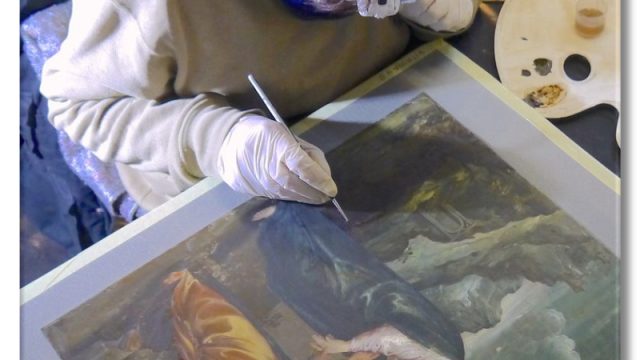Adriana García Gómez
Conservator and Restorer of Cultural Heritage
LIGHTING
Let us begin with one of the most problematic issues: light. Although it acts differently depending on the materials of the work, its action is irreversible and progressive, and its damage permanently detracts from the value of the collections. Of course, not all types of light are a problem, only those that emit harmful radiation. To explain this clearly, it is not advisable to expose works of art to natural light or to incandescent or halogen bulbs (all light sources that emit heat energy or ultraviolet radiation). Darkening, yellowing or discolouration may be some signs of exposure to these. Although this may at first appear visually prominent, the damage they cause also extends to the structure and stability of many materials. As a solution to artificial light sources, LED lights can be used. These devices do not emit ultraviolet or infrared radiation, and as a result of the lack of the latter, there is no increase in the surface temperature of the building. They provide great energy efficiency, and there is also a wide range of shades that allow them to adapt better to the exhibition space.
As far as natural light is concerned, there are various ultraviolet filters on the market, including plastic films with different qualities and characteristics that can be adhered to the inside of the window, thus reducing the levels of UV radiation.
TEMPERATURE AND HUMIDITY
Secondly, we have temperature and relative humidity. Although these two variables have different risk scales, the measures to be taken and their repercussions on the work of art are related. This can lead to different damage depending on whether there are sharp variations in the figures on one or both scales at the same time.
In the domestic sphere, the overall values will depend greatly on our comfort, the climate and the living environment. By the latter, we mean that the average humidity and temperature levels throughout the year will not be the same in a house on the outskirts of Madrid as in a house on the coast of Valencia.
The type and severity of the deterioration that may occur, as with other risk factors, will be reflected in the materials used in the paintwork. So, what humidity and temperature values should we consider? Due to all the above conditions, we cannot set precise figures that we will be able to faithfully maintain and that are ideal for each material used in the work. However, we can inform ourselves about the general values and special care to be taken regarding the two scales in Guidelines for Humidity and Temperature for Canadian Archives by Stefan Michalski.
In the case of oil and acrylic canvases, which are usually of medium sensitivity, there is a general consensus on the values for humidity and temperature for the two scales.
As far as temperature is concerned, there are fewer problems, as the temperature is generally between 16 and 25°C, which is very compatible with our comfort. To generate serious alterations, the temperature would have to drop to between 5 and 10°C for acrylic paints or -5°C for oil canvases, a very improbable situation in the home.
Although the latter considerations are fundamental for the preservation of the work, it is not the average values, which change progressively over long periods of time, that must be treated with particular attention. We thus present the drastic changes that take place in a very short time, which we call fluctuations. Against all of the above factors, the most effective measure is to implement continuous environmental monitoring and to refrain from exposing the building site in areas where levels rise or fall rapidly, e.g. radiators, water outlets, humidifiers or air vents.




